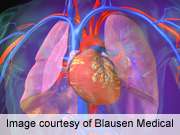(HealthDay)—Computed tomographic (CT) perfusion imaging shows higher overall diagnostic performance than single photon emission computed tomography (SPECT) perfusion imaging for the diagnosis of coronary artery disease (CAD), according to a study published in the August issue of Radiology.
Richard T. George, M.D., from the Johns Hopkins University School of Medicine in Baltimore, and colleagues conducted rest and adenosine stress CT perfusion imaging and either exercise or pharmacologic stress SPECT before and within 60 days of coronary angiography in 381 patients (November 2009 to July 2011).
The researchers found that CAD was diagnosed in 60 percent of the patients. The diagnosis of CAD (stenosis ≥50 percent) had a per-patient sensitivity and specificity of 88 and 55 percent, respectively, for CT perfusion imaging and 62 and 67 percent, respectively, for SPECT. Area under the receiver operating characteristic curve (Az) values were 0.78 and 0.69 (P = 0.001). For single- and multi-vessel CAD, the sensitivity of CT perfusion imaging was higher than that of SPECT. Sensitivities for left main, three-vessel, two-vessel, and one-vessel disease were 92, 92, 89, and 83 percent, respectively, for CT perfusion imaging and 75, 79, 68, and 41 percent, respectively, for SPECT.
"The overall performance of myocardial CT perfusion imaging in the diagnosis of anatomic CAD (stenosis ≥50 percent), as demonstrated with the Az, was higher than that of SPECT and was driven in part by the higher sensitivity for left main and multi-vessel disease," the authors write.
Several authors disclosed financial ties to the medical device industry.
More information:
Abstract
Full Text (subscription or payment may be required)
Journal information: Radiology
Copyright © 2014 HealthDay. All rights reserved.


















